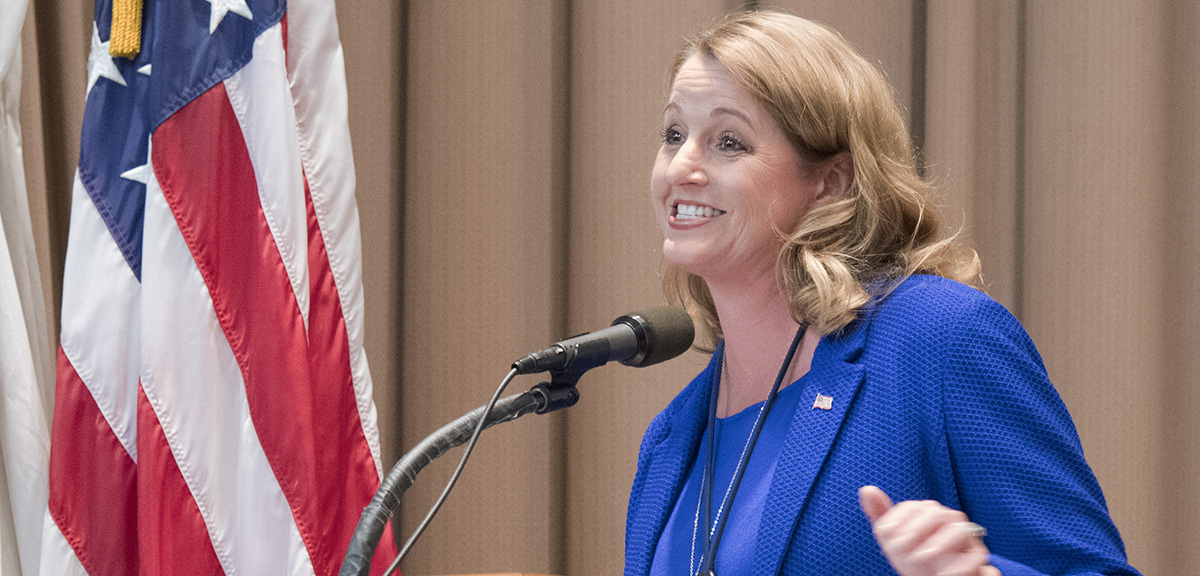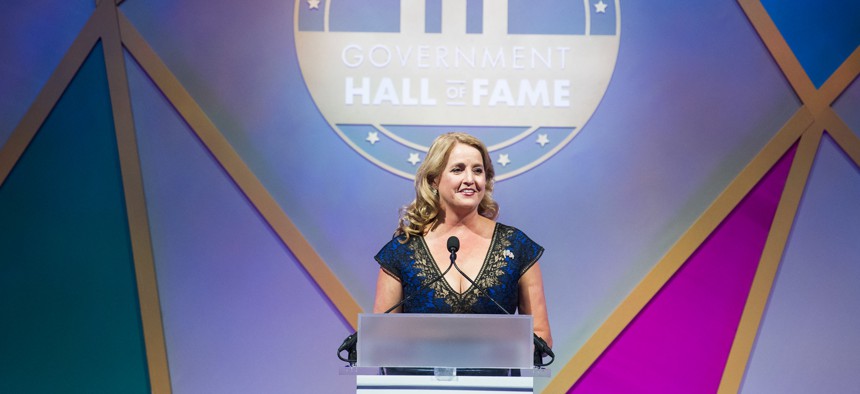Federal CIO Suzette Kent on Tools and Techniques for the New Way of Work
Federal agencies were modernizing their information technology systems and business processes at varying rates. Then came the pandemic.
Suzette Kent, who has served as the Trump administration’s federal chief information officer since February 2018, is a veteran of business transformation efforts at private companies such as EY, J.P. Morgan and Accenture. But like everybody else, she’s never faced anything quite like managing through a pandemic. In Kent’s case, that involves scrambling to ensure federal agencies have the tools and systems in place to manage in a time of “maximum telework.”
Kent spoke with Government Executive Editor in Chief Tom Shoop recently about her efforts and her overall approach to managing federal IT modernization. Excerpts from that interview follow.
How are you adjusting to the new way of work?
Especially in the beginning, what was incredibly challenging was the work cycle was almost continuous, especially for some of the agencies that had to set up some of the recovery capabilities in just days. So it was literally around the clock, and we were putting out different pieces of guidance that had to be discussed and reviewed, also on that 24-hour cycle. It was incredibly intense. I met with the CIOs and CISOs every single day, and then one-on-one individually, more than that. We were just moving so quickly.
We had to look at things to say, how do we create new and different boundaries, especially when people are working from their living space? And what does that look like? And how do you back off from answering the phone 24/7? I’m not joking: The phone would ring at 5 in the morning, the phone would ring at 2 at night. When we saw that the road was longer, we had to get to something sustainable, so that we had people who were fresh. And that’s where we looked at different types of shift work. And we had to collaborate differently because we were moving so quickly.

People handle change very differently. We all know that, right? That’s a big part of everything you do, whether it’s technology or business processes. Government has a very well-defined, albeit sometimes rigid, process. And even in this, we tried to follow all those things as much as possible, but just make them go faster. So sometimes people had 30 minutes to review something, not three weeks. That created different kinds of pressure. Most people rose to the occasion. Some people were challenged by it.
One of the biggest positives, though, is that we learned that a lot of the tools that we invested in, and those capabilities, will work. They help us achieve mission continuity and we can use them at scale for prolonged periods of time. Now we have the evidence. We know that we can do it, we know that the workforce can do it, we know the capabilities can perform in the way we expected. That’s going to give us some ability going forward to reconsider what the work day looks like, and what that might mean from a time and location standpoint.
What are some of the tools that are paying off now?
We had a huge push to move to cloud email. Over the last two years, agencies went from the low 30s to the majority of them there. So we were able to scale and continue to communicate. All agencies did not have expanded ability to use collaboration tools across their agencies.
We’ve talked about electronic and digital capabilities, whether that’s digital signatures and secure messaging for certain things, or bigger in digital services to citizens. You know, you can look at five or six of the agencies where moving away from paper-based processes to digital has been a goal. But it’s probably one of the areas where we were moving at an OK pace, but not aggressively. And this created an opportunity where we need to be more aggressive.
We had to create things we did not have before, and we were able to use modern, scalable, configurable platforms.
Has this experience changed the way you act as a manager?
I wouldn’t say it has changed my style. In many of the things I've done in my career, I’ve been involved in responses to things, whether it was the financial crisis, a hurricane, a typhoon. My overall style doesn’t change, but when crises occur, you have to do things differently. There are some tactics that I revert back to, like communicating fast even if you don’t have all the information. That’s kind of hard for some government folks.
You can’t trust that everything’s going to get through the process in exactly the same way, shape or form. You move to a different frequency and intensity of communication.
My style is very outcome-based—and probably people would say impatient—but I think that’s a good thing. I mean impatience in a good way. I’m always asking, “Can we go faster? What else could we be doing?” I always try to be inclusive, meaning everyone who has a stake in the game is at the table and part of the conversation.
Even when you’re building and developing a product—and when I say product, it could be a policy, a piece of guidance, an approach to a project, whatever—when it goes through a single stovepipe and you come out with a product and you haven’t talked to the other people involved, sometimes you miss that opportunity to make it better. That’s really important in a crisis situation when you’re building—whether it’s technology or business processes—that don’t exist today and are for a very specific purpose.
What have you learned from the shift to maximum telework across government?
In the technology community, people are very comfortable with the tools, obviously. They take their computer with them everywhere, and many of them prefer electronic activity versus paper-based. That is not the mode of behavior of everyone in the federal government. And so, we saw people asking to take printers home. We saw people who didn’t take their equipment home.
We saw individuals—even though their agency had great collaboration tools—they’d never actually used any of them, because they were comfortable in a face-to-face, physical meeting setting with paper agendas and those types of things. Switching to this environment didn’t give anyone a choice. To continue your work you had to adopt and become familiar with tools. You had to do your work digitally.
Could it be more elegant? Are there things we can continue to do to improve? Of course. But that was a big learning point.
We had a lot of people who were very comfortable switching to telework. There are many who weren’t. They missed the interaction with their peers, they liked the debate and those kinds of interactions—especially in policy development. People have had to reassess how they get work done, and we’ve had to be flexible with that.
What I’m frankly excited about, speculating for the future, is that because we’ve been able to maintain operations in so many situations, I certainly hope that it lets agencies think about what kind of footprint is necessary. As we think about the physical setup of our federal buildings—in some of them it may take more time to create distancing options or to reconfigure to make safe workplaces—some agencies are thinking about shift work.
How would you characterize the status of IT modernization in government in general right now?
Generally, the things that were under IT modernization were focused on digital processes, on moving off of legacy systems, on moving to commercially available software solutions. In the cybersecurity area, we have a lot of metrics that are part of the President’s Management Agenda that are tracked every quarter and reported on around device security—both your phone and your PC. I’m very glad those were in our focus area, because look at what we’re doing now. Those have become people’s primary mode of work.
So the efforts are continuing. You’ve seen the things that have come through the Technology Modernization Fund, but that’s a small piece of some things that gets a lot of attention. If you look at each agency’s roadmap and their own strategic plan, there’s significant work going on—getting legacy applications moved, getting the infrastructure completely redone and resilient. There are a few that are kind of behind where they’re supposed to be, but most agencies have made really good progress.
Look at what’s happened with the census. The investment in taking the census online was historic. And it’s proven not only to be wise, it’s working very well, on a backbone of commercially configurable software. So the efforts are continuing. What I think it shows, though, is that we need to be more aggressive in determining what things can be done in a digital manner, and moving that way.
What have you learned from your time working in government?
What I have learned—and I’ll honestly say it was a little bit of an eye-opener—is that the stakeholder alignment process is much more complicated than it is in the private sector. There’s a lot of decision-makers getting from idea to implementation—funding, policy, rules, administration priorities. How does it fit into all these laws? Whose jurisdiction does it impact?
It’s significantly more complicated than if you compared it to some types of private sector efforts. Because of the great things we want to do to make sure the acquisition process is fair—and there’s a lot of visibility and transparency—it also is a really complicated process. The amount of time and effort that’s spent in that process—and I understand why—does not make it easier.
I will say, I learned it, but I don’t accept it, and I think that’s a good thing.
NEXT STORY: 5 Reasons to Switch Jobs During a Pandemic




